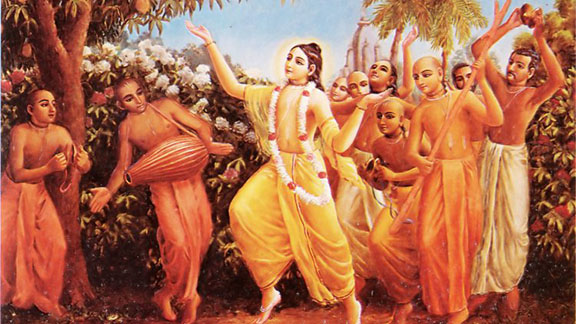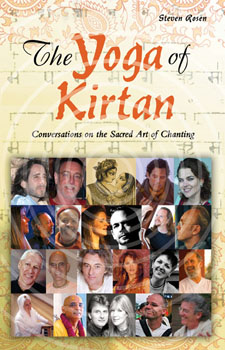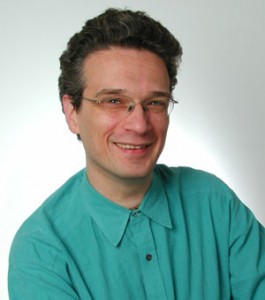 Steven J. Rosen’s book, The Yoga of Kirtan, offers interviews with 21 musicians—including Krishna Das, Jai Uttal, Deva Premal, Snatam Kaur, David Newman, Ragani—leading the kirtan revolution. The book focuses not only on kirtan but on the lives of those being interviewed in order to offer readers a peek into the world of kirtan through the personalities who perform kirtan. In this interview, the author discusses the book and the sonic spirituality that is the essence of kirtan.
Steven J. Rosen’s book, The Yoga of Kirtan, offers interviews with 21 musicians—including Krishna Das, Jai Uttal, Deva Premal, Snatam Kaur, David Newman, Ragani—leading the kirtan revolution. The book focuses not only on kirtan but on the lives of those being interviewed in order to offer readers a peek into the world of kirtan through the personalities who perform kirtan. In this interview, the author discusses the book and the sonic spirituality that is the essence of kirtan.
Integral Yoga Magazine (IYM): What were some realizations or perhaps common threads that ran through your interviews for the book?
Steven Rosen (SR): One of the first realizations I had as I was interviewing these people, was that conversation itself is a bit like kirtan because it’s call and response. I’d ask and they’d respond and that would provoke me to ask more questions. The ecstasy of the conversation came from this back and forth dynamic. This is the same thing that happens in kirtan. And then, as each conversation came to a close, it was like the end of a kirtan, when you are basking in silent bliss. It was all spontaneous and joyful.
As I conducted the interviews with Snatam Kaur from the Sikh tradition, and Yofiyah, who recorded the CD, Kabbalah Kirtan, I realized that kirtan is truly universal. Calling out to God, glorification of God and the call-and-response format is present in every religious tradition and that was very inspiring to me. Recently, in fact, I went to hear Andrew Hahn, the “Kirtan Rabbi,” at the Integral Yoga Institute in New York, and it was ecstatic. No matter what the tradition, kirtan is so user-friendly. According to the wisdom traditions and scriptures of India, the yogic practice most recommended in this modern age is kirtan. To see kirtan being used in the various religious traditions of the world seems to support that idea.
IYM: In your book, you talk about Sri Chaitanya Mahaprabhu as the father of kirtan. Was there kirtan before his time?
SR: Kirtan predates Sri Chaitanya. There is a particular quote from the Bhagavata Purana, an ancient text considered the cream of India’s sacred scriptures: “My dear king, although Kali-yuga is full of faults, there is still one good quality about this age: Simply by chanting the holy name of God, one can become free from material bondage and be promoted to the transcendental kingdom” (12.3.51). Though Sri Chaitanya infused the practice with new life, sages had long engaged in call-and-response glorification of God. The seeds of kirtan can be found in the Vedic literature, thousands of years old, and, as time went on, saints and sages from Bengal, Maharashtra, South India and elsewhere nurtured the flower of God’s names with their own melodious styles and techniques—centuries before the advent of Sri Chaitanya. But he brought it out in the open and gave it to the world as a yogic science.
 I found that quite a number of kirtaniyas who have popularized kirtan come from the lineage of Sri Chaitanya. The obvious ones are from the International Society for Krishna Consciousness, which is part of the same Gaudiya Vaishnava lineage. Srila Prabhupada popularized kirtan and the chanting of the Maha Mantra (Hare Krishna, Hare Rama) after coming to the USA in 1965. In my book, I interviewed disciples of Srila Prabhupada, including Yamuna Devi, Dravida Das, Vaiyasaki Das, among others. But I was surprised to find that Krishna Das and Jai Uttal were also influenced by this lineage. Though they are both disciples of Neem Karoli Baba, they told me that they initially developed the taste for chanting upon hearing the Gaudiya Vaishnavas chanting their mantras, Krishna Das in India and Jai while still in the US. Jai Uttal said that when he was a kid in New York City, he’d follow the Hare Krishnas around. He’d stay a block or so behind because he didn’t want to get involved, but he loved the sound and so he’d follow them for hours. It was very profound for me to hear that many who are popularizing kirtan now have been influenced by the lineage of Sri Chaitanya. That’s where the shakti or power comes from.
I found that quite a number of kirtaniyas who have popularized kirtan come from the lineage of Sri Chaitanya. The obvious ones are from the International Society for Krishna Consciousness, which is part of the same Gaudiya Vaishnava lineage. Srila Prabhupada popularized kirtan and the chanting of the Maha Mantra (Hare Krishna, Hare Rama) after coming to the USA in 1965. In my book, I interviewed disciples of Srila Prabhupada, including Yamuna Devi, Dravida Das, Vaiyasaki Das, among others. But I was surprised to find that Krishna Das and Jai Uttal were also influenced by this lineage. Though they are both disciples of Neem Karoli Baba, they told me that they initially developed the taste for chanting upon hearing the Gaudiya Vaishnavas chanting their mantras, Krishna Das in India and Jai while still in the US. Jai Uttal said that when he was a kid in New York City, he’d follow the Hare Krishnas around. He’d stay a block or so behind because he didn’t want to get involved, but he loved the sound and so he’d follow them for hours. It was very profound for me to hear that many who are popularizing kirtan now have been influenced by the lineage of Sri Chaitanya. That’s where the shakti or power comes from.
IYM: How can we get the most out of kirtan?
SR: Anyone can chant, young or old, healthy or infirm, rich or poor, male or female. In fact, kirtan is the only yogic practice that even brings benefit to those not directly engaged in it! It benefits not just the people leading the chanting, not just the people responding in the chanting session, but also those who may just be passing by and who hear the chanting, without being conscious of it. So, in that sense, chanting can bring all types of benefits to many people. It brings inspiration, joy, healing and purification. It’s easy.
But let me say this: Mantras come from certain lineages. A mantra can’t just be manufactured. In fact, there is a scriptural injunction in the Padma Purana that states: “Sampradaya-vihina ye mantras te nisphala matah.” This means, “If your mantra does not come through the authorized lineage, it will not be effective.” Nisphala means that it will not produce the ultimate fruit of love of God. Subsidiary fruits are easily attained, but the ultimate fruit only appears when the mantra is received from a master. There is a methodical process to properly receive mantras, and the highest quality kirtans derive from people who get their mantras in this way.
IYM: In the West, we don’t tend to view kirtan as a science.
SR: Sri Chaitanya’s immediate followers, the Six Goswamis of Vrindavan, explained chanting as a yogic science. Based on Sri Chaitanya’s teachings, they brought out the inner meaning—that by chanting God’s name, we are associating with God to the point of becoming intimate and of having a relationship with Him/Her. Sri Chaitanya brought this out experientially. And the Goswamis documented it so all of us could benefit from Sri Chaitanya’s spontaneous love. On one hand chanting is ecstasy and easy to perform, and on the other hand it is a science. When we love someone, there is a feeling of love, but if we want to develop a deep and committed relationship with our beloved, there are certain steps we must take; there’s a certain procedure. For love to blossom, we have to show our love for a given person, we have to nurture them and do other things that help them feel loved. No? There’s a way to do this. We may love our husband or wife, but what do we do to help our partner feel loved? Though love is natural and from the heart, there’s actually an art and science to how one develops and shows one’s love. Psychologists and sociologists have long studied the art and heart of relationship. Just as there are signs and signals of a healthy and harmonious relationship, there are things that we can do to help or harm our relationships. That’s the science of love.
What I’m trying to say is this: Sri Chaitanya was like the exemplar of kirtan. When he would chant, people would see he was in ecstasy and they’d say, “I want to be like him.” The Six Goswamis documented the different stages of ecstasy and what his body went through. They wrote down the science of how to chant properly and experience the ecstasy. They documented what works and what doesn’t work in building a relationship with the divine through kirtan, and this became the Yoga of kirtan.
IYM: Many world scriptures speak about the power of the holy name.
SR: Yes, the world’s major religious traditions concur in regard to the importance of God’s name. For example, in the Bible, King David preached, “From the rising of the sun to its setting, the name of God is to be praised” (Psalms 113.3). Saint Paul said, “Everyone who calls upon the name of God will be saved” (Romans 10.13). Prophet Muhammad, in the Koran (87.2), counseled, “Glorify the name of your Lord, the most high.” The Buddha declared, “All who sincerely call upon my name will come to me after death, and I will take them to paradise” (Vows of Amida Buddha, 18); and the Vaishnava scriptures repeatedly assert: “Chant the holy name, chant the holy name, chant the holy name of God. In this age of quarrel there is no other way, no other way, no other way to attain spiritual enlightenment” (Brihad-Naradiya Purana 3.8.126). This is all kirtan.
IYM: What were some of the highlights for you in the interviews you conducted?
SR: There were so many! Agni Dev’s interview was the most exciting kirtan story I’d ever heard! He was from Trinidad and came to New York and was doing kirtan in the winter. He got frostbite and hypothermia and, the way he describes the experience, well, someone should make a movie about it! Another that I found particularly amazing was Yamuna Devi’s, story about the first Hare Krishna mantra recording that George Harrison arranged with Apple Records. Then there was Karnamrita’s story about how she had grown up in an ashram, left everything, had nothing to do with it and then went to Vrindaban, studied singing, and then got back into kirtan on her own terms. There are so many great stories embedded in these interviews. I wanted to put together a readable book that allows readers entrance into the history, emotion and culture of sacred chant through the stories of those who have popularized kirtan. I think, through their stories, the reader comes to understand that kirtan is not really about context, culture or language—it’s about a pure heart calling out to the divine. What we are talking about here is sonic spirituality, which is at the heart and soul of all wisdom traditions.


Steven J. Rosen is editor-in-chief of the Journal of Vaishnava Studies, a biannual publication exploring Eastern thought. He is also the author of over twenty books on Indian philosophy. His recent titles include Essential Hinduism (Praeger, 2006), Krishna’s Song: A New Look at the Bhagavad Gita (Praeger, 2007), and Black Lotus: The Spiritual Journey of an Urban Mystic (Harinam Press, 2007). He is an initiated disciple of His Divine Grace A.C. Bhaktivedanta Swami Prabhupada. For more information, please visit his website: yogaofkirtan.com.
Reprinted from Integral Yoga Magazine, Winter 2009 issue

